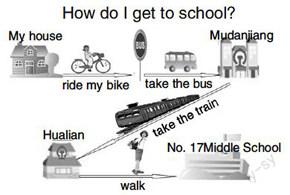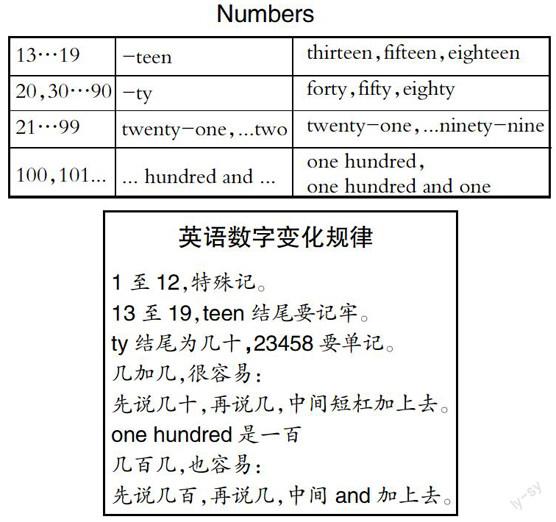Unit 3 How do you get to school? 教学设计及思考
2016-05-30王佳张丽华
王佳 张丽华



【本课选自人教版义务教育课程标准实验教科书《英语》(新目标)七年级下册。】
一、教材内容与分析
本单元的话题是“谈论交通方式”,Section A部分展现了学生用不同的交通方式上学的场景,自然而然地将学生带入到有关彼此上学方式及出行花费的时间等问题的讨论中。1a-1c呈现了交通方式的名称,以及表达“使用某种交通方式”的动词搭配,如:take the bus, ride a bike等,还导入谈论出行方式的句式。2a-2d部分进一步深化了“出行”话题,先让学生学习并掌握英语十位数和百位数的表达方式,再让学生捕捉听力对话中的数字信息,然后训练学生询问和回答两地距离和出行花费时长。本节课是一节典型的听说课。
二、教学目标
1. 语言知识目标:
① 学习掌握词汇subway,train,minute,take,by bike等。
② 学会谈论、描述交通方式及距离的表达方法。
③ 熟练掌握询问交通方式和花费时间的句式:
How do you get to school? I take the bus.
How long does it take from ...to ...?
It takes sb. some time to do sth.
2. 语言技能目标:
① 听力技巧指导,听关键词,快速记录;
②能根据录音判断交通的方式、花费的时间及距离;
③能运用简单的语言对自己及他人去某地的路线、方式进行描述。
3. 情感态度:
倡导自觉遵守交通法规及礼貌乘车;不同的出行目的可以选择不同的交通工具;不同的交通工具带来不同的心理感受。让学生懂得从环保这一角度出发,了解交通工具给环境带来的影响。
三、教学重、难点
教学重点:各种交通工具的英文名称、表达“乘坐某种交通工具”的动词短语,以及以how引导的一般现在时的特殊疑问句及简略回答。
教学难点:how引导的特殊疑问句中助动词的使用及语序,以及how long引导的特殊疑问句的回答。
四、教学步骤
Step I Leading-in and new words
1. Leading-in
T: Are you ready?
Ss: Yes.
T: Class begins.
Ss: Good morning, teacher.
T: Good morning boys and girls.
T: OK! Boys and girls! Im your teacher for a long time. Do you know where my house is? Its in Mudanjiang. Its far from Hualin, but I work in Hualin. Do you want to know how I go to work every day? OK. Today lets learn Unit 3 How do you get to school? Section A 1a ~ 2d.
(Write “Unit 3 How do you get to school? Section A 1a ~ 2d” on the blackboard.)
2. Present the new words and new phrases
T: Now let me tell you how I go to work every day. I get up at 5 oclock every day. After breakfast, I leave for school at around six forty. First, I ride my bike to the bus station. Then I take the bus to the Mudanjiang Train Station. Next, I take the train to the Hualin Train Station. Finally, I walk to my school. This is how I go from my house to my school.
T: Please read after me, train, T-R-A-I-N, train.
(Teach the other words: bike, ride ones bike...)
T: I show some kinds of transportation. Here are some other kinds of transportation.
(Teach the other words: subway, take a subway...)
T: OK. Lets read together.
3. Practice the new words and new phrases
(Let the students know the meanings of “take乘坐” and “take a/the+交通工具”and write it on the blackboard.)
T: Good job. Thanks.
(设计说明:以教师亲身经历为话题,以教师上班路线为主线创设情境导入新课,既贴近生活又顺理成章,让学生在情境中理解生词,激发了学生的求知欲,能够积极投入到学习中。在教授单词过程中,以one by one的方式让学生依次读单词,充分调动学生的积极性,全面参与,共同进步。)
Step II A guessing game
T: OK, Lets play a guessing game. You can guess the words and phrases according to my description. OK?
Ss: Yes.
T: It has two wheels, you can ride it.
S1: Bike, take a / the bike.
( Let the students guess “ship” and “take the ship”...)
(设计说明:通过猜交通工具的游戏,巩固单词、短语,图文并茂,激发学生学习兴趣,使学生记忆深刻。)
Step III New drills
1. Present the new drills
T: Look at the picture. Its my pen pal Bobs school. The students take different kinds of transportation to get to school. Please open your books. Turn to Page 13. Lets do 1a together. One minute!
(The teacher checks the answer.)
T: There are so many kinds of transportation. How do you get to school?
(Write “How do you get to school?”on the blackboard)
2. Practice the new drills
T: Lets work in pairs like this:
S1: How do you get to school?
S2: ...
(设计说明:利用学生熟悉的明星和交通工具的图片,操练新句型。单词呈现后紧跟句型练习,逐一突破,分散与攻克了难点。)
Step IV Listening practice
1. Listening practice
T: Bob is my pen pal. He takes the train to school. What about other students? Lets listen and do 1b.
(The teacher plays the tape, then checks the answer.)
T: Just now you knew my ways to school. What about my family? He is my husband. How does he get to work?
Ss: ...
T: We can also say “He goes to work by car.”
(Teach other phrases like this: by bike, on foot...)
T: Who can sum up how to change the verb-phrases into the preposition-phrases?
Ss:...
T: Li Yong is a famous star. He is funny. How does he go to work?
Ss: ...
2. Pairwork
T: Lets work in pairs. Ask and answer according to the pictures.
3. Present the new drills
① Find out the rules of the numbers
T: Just now we have learnt the kinds of transportation. Next we will talk about the time we spend. We usually use numbers to show the time. Lets review the numbers we learnt. Lets count 1~12, 13~19...
Ss: ...
T: Who can find out the rules?
Ss: ...
T: Good job! I give you a chant to help you remember the rules.
(设计说明:此环节先让学生讨论总结数字的规律,再利用口诀进行数字的学习,学生记忆起来快而容易。同时为接下来新句型的学习打好基础,排除障碍。)
② Listening practice
T: Lets listen and repeat 2a. Then write the correct number next to the word.
③ Present the new drills
T: Do you remember how I get to school? Yes. Its my route. Can you guess the time I spend? We can ask the time we spend like this: How long does it take?
( Let the students know the meanings of “how long”, “take花费”and “It takes sb. some time to do sth.”)
④Practice the new drills
T: OK, you know my transportation and the time it takes. What about my friends? Lets listen and do 2b.
(The teacher plays the tape, then checks the answers.)
⑤Role-play the conversation
T: Student A is Jane and student B is Tom. Use the information in 2b to make conversations.
(设计说明:通过让学生捕捉听力对话中的数字信息,完成知识的输入,然后训练学生询问和回答两地距离和出行花费时长,以此来巩固输入的知识,完成输出。)
Step V Pairwork
T: Now you know how my friends and I get to school. What about you? Now Lets make a conversation about how you get to school with your partner.
Ss: ...
T: Excellent/ Good job!
(设计说明:创设贴近学生生活的语境,两两进行对话,培养合作意识,突出教学重点,攻克教学难点。)
Step VI Group work-Make a survey
T: My pen pal Bob wants to know about how you get to school and how long it takes. Please help me to make a survey. Now work in a group of six. Then choose one student in your group to make a report and tell us which transportation is the best for our earth. 3 minutes, please.
Ss: ...
T: Perfect! You are really the best. Lets choose walking or riding the bike to some places as much as we can.
(设计说明:通过调查汇报学生选择的上学交通方式和花费的时间,可以使各小组的学生创造性地使用语言,倡导合作学习,在“做”中再次巩固目标语言。)
Step VII Summary
T: The time is limited. Lets sum up. What have you learnt in this lesson? Who can sum up? You can say it in English or in Chinese.
Ss: ...
T: Perfect!
Step VIII Homework
T: Homework for today: First, make a survey about how your relations get to school/work. Second, write a report according to your survey.
T: Class is over. Goodbye, boys and girls!
Ss: Goodbye, teacher!
板书设计:
Unit 3 How do you get to school? Section A 1a~2d
五、思考与说明
1.以人为本,注重语言输入
语言输入是语言输出的前提,没有大量的语言输入就无法实现语言输出。因此教师在本节课的教学中正视学生个体差异,充分考虑到不同发展基础的学生的不同需求,引导学生快乐学习。
(1)创设情境,学习新知。本节课由教师上班乘车方式为话题导入新课,并通过生动形象的路线图的展示,让学生整体感知所学单词和短语,并创设情境,通过师生对话,图片展示,头脑风暴等调动学生所学知识,激发学生学习热情,学习新知识。
(2)听力训练,感知语言。通过听前对学生进行听力技巧方面的指导,听关键词并速记,提高了学生的听力能力。并且在听前给学生输入补充信息,此环节先让学生讨论总结数字的规律,再利用口诀进行数字的学习,学生记忆起来快而容易。听力输入让学生感知语言,学习语言结构,同时为接下来语言的输出打好基础,排除障碍。
2.以本为本,多重解读文本
教师在本课前对教材进行了深入的分析,多重解读文本,根据学情确定了本节课的教学重点是掌握各种交通工具的英文名称、表达“乘坐某种交通工具”的动词短语,以及以how引导的一般现在时的特殊疑问句及简略回答。教学难点是how引导的特殊疑问句中助动词的使用以及语序,以及how long引导的特殊疑问句的回答。通过各个教学环节的由易到难,层层递进来突破重点、攻克难点。
本节课教学设计最大的亮点,是以教师上班乘车路线图为主线,贯穿始终,且反复使用,贴近生活激发学生学习英语的兴趣。比如:课堂导入、新单词的呈现、新句型的讲授都利用了同一幅路线图,主线清晰,便于学生理解和记忆,实效性很强,有利于本节课教学重点的突破。
3. 以能为本,注重语言输出
听说课教师应给学生营造良好的课堂教学环境,给学生创造“说”的机会,从而培养学生的语言交际能力。笔头练习活动与口头听说活动结合起来,比如听力训练的1b和2a,以及任务活动make a survey,都分层次设计了相应的问题和活动,以此来迎合不同层次学生的需求,让各层次学生都能开口说话,动笔写字,都能有所收获。
